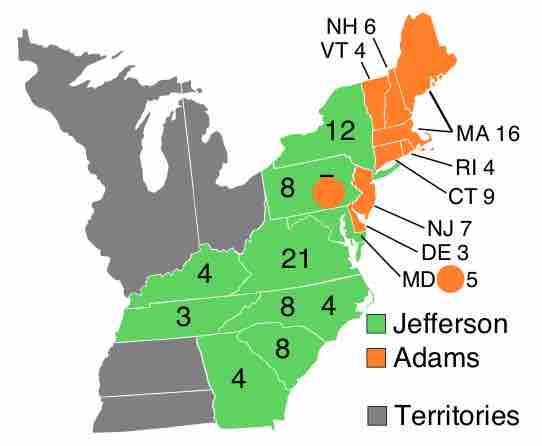Debate Over the Presidency and Judiciary
During the Constitutional Convention, the most contentious disputes revolved around the composition and election of the Senate, how "proportional representation" was to be defined, whether to divide the executive power between three people or invest the power into a single president, how to elect the president, how long his term was to be and whether he could stand for reelection, what offenses should be impeachable, the nature of a fugitive slave clause, whether to allow the abolition of the slave trade, and whether judges should be chosen by the legislature or executive. Most of the convention was spent deciding these issues, while the powers of legislature, executive, and judiciary were not heavily disputed .
Constitutional Convention in Philadelphia
During the Constitutional Convention, some the most contentious disputes revolved around the composition of the Presidency and the Judiciary.
James Madison's Influence
While waiting for the convention to formally begin, James Madison sketched out his initial draft, which became known as the "Virginia Plan" and which reflected his views as a strong nationalist . By the time the rest of the Virginia delegation arrived, most of the Pennsylvania delegation had arrived as well. The delegates agreed with Madison that the executive function had to be independent of the legislature. In their aversion to kingly power, American legislatures had created state governments where the executive was beholden to the legislature and by the late 1780s, this was widely seen as being a source of paralysis. The Confederation government was the ultimate example of this.
Portrait of James Madison
James Madison authored the Virginia Plan, which contained important provisions on the presidency and judiciary.
Madison believed that in the American states, this direct link between state executives and judges was a source of corruption through patronage and thought the link had to be severed between the two, thus creating the "third branch" of the judiciary which had been without any direct precedent before this point. Madison, however, did not believe that the judiciary should be truly independent, but rather be obligated to the legislature not the executive. By insisting on the independence of the judiciary, Madison stepped away from the Articles of Confederation to create something entirely new. At the convention, some sided with Madison that the legislature should choose judges, while others believed the president should choose judges. A compromise was eventually reached that the president should pick judges and the Senate confirm them.
The Early Debate
One of the most pressing issues during the early debate was the election of the president. Few agreed with Madison that the executive should be elected by the legislature. There was widespread concern with direct election, because information diffused so slowly in the late eighteenth century and because of concerns that people would only vote for candidates from their state or region. A vocal minority wanted the national executive to be chosen by the governors of the states.
This was one of the last major issues to be resolved and was done so in the Electoral College. At the time, before the formation of modern political parties, there was widespread concern that candidates would routinely fail to secure a majority of electors in the Electoral College. The method of resolving this problem, therefore, was a contested issue. Most thought that the house should then choose the president, since it most closely reflected the will of the people. To resolve this dispute, the convention agreed that the house would elect the president if no candidate had an Electoral College majority, but that each state delegation would vote as a block, rather than individually .

Electoral College 1800
The Constitutional Convention agreed that the house would elect the president if no candidate had an Electoral College majority, but that each state delegation would vote as a block, rather than individually.
Modifications
The Committee of Detail was a committee established by the United States Constitutional Convention on June 23, 1787 to put down a draft text reflecting the agreements made by the convention up to that point, including the Virginia Plan's 15 resolutions. It was chaired by John Rutledge, and other members included Edmund Randolph, Oliver Ellsworth, James Wilson, and Nathaniel Gorham.
The committee shortened the president's term from seven years to four years, freed the president to seek re-election after an initial term, and moved impeachment trials from the courts to the Senate. It also created the Office of the Vice President whose only roles were to succeed a president unable to complete a term of office and to preside over the Senate. The committee transferred important powers from the Senate to the president who now, for example, would be given the power to make treaties and appoint ambassadors. One controversial issue throughout much of the Convention had been the length of the president's term and whether the president was to be term limited. The problem had resulted from the understanding that the president would be chosen by Congress; the decision to have the president be chosen instead by an electoral college reduced the chance of the president becoming beholden to Congress, so a shorter term with eligibility for re-election became a viable option.